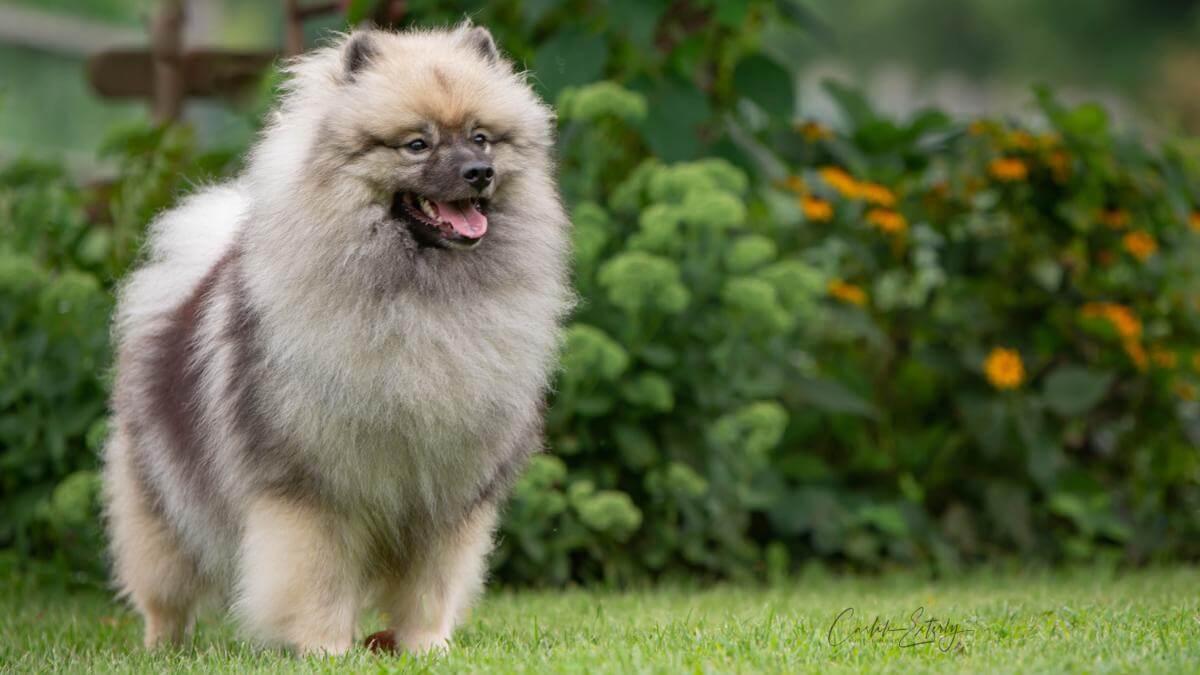


Home » The Keeshond: A Primer

This article was originally published in Showsight Magazine, August 2017 issue.
The Keeshond (pronounced kayz´•hawnd) is a well-balanced, medium-sized dog, with an alert carriage, an intelligent expression and a spectacular, double coat. The most easy-going of the spitz-type breeds, the Keeshond has always been bred to be a companion. He is a true family dog that is devoted to his “people” and possesses a special fondness for children.
Though descended through the most ancient of lines (the northern spitz-type dogs), Keeshonden (the plural of “Keeshond”) are believed to have originated in Holland (the central provinces of the present-day Netherlands) and Germany. Natural watchdogs, Keeshonden were known for traveling on the barges of merchants and freight-carriers that plied the waterways of Holland and Germany. Keeshonden were also used extensively on Dutch farms as “utility” dogs. They were very much the dog of the working middle-class. The Keeshond gained its greatest notoriety in the 18th Century. The constant and faithful companion of Cornelis (“Kees”) de Gijselaar, a leader of the Dutch “Patriots” party, the little barge dog became a widely known political symbol. Though the Patriots were eventually defeated and symbols of the losing side quickly became scarce, the name “Keeshond” has endured—it literally means, “Kees’ dog.” Keeshonden remained obscure until the early 20th Century when a young Englishwoman, Gwendolen Hamilton Fletcher (later Mrs. Wingfield-Digby of Sherborne Castle), while vacationing in Holland, became enamored of the dogs she saw barking and running up and down the length of barges that she encountered. She purchased two barge dog puppies and brought them home. Through Mrs. Wingfield-Digby’s efforts, and those of other early enthusiast breeders such as Baroness Burton and Alice Gatacre, the Dutch Barge Dog (later renamed “Keeshond”) was recognized by Britain’s Kennel Club in 1926. While most Keeshonden in the United States developed from British breeding, it was a German immigrant, Carl Hinderer (Scholss Adelsburg Kennel), who was most responsible for gaining American Kennel Club recognition for the breed in 1930.
The Keeshond is a handsome dog that attracts attention with his dramatic black, gray and cream coloring, standoff coat, profuse ruff and “spectacled”, fox-like expression. The compact, sturdy, balanced, short-coupled body of the Keeshond, the tail carried tightly curled over his back, and the slight-to-moderate reach and drive of his leg movements are ideal characteristics for a dog that was once expected to stand watch over the crowded, rolling deck of a boat. The Keeshond’s double coat includes a coarse outer layer that helps to keep rain, snow and dirt from reaching his skin, and a soft, downy undercoat which keeps him warm. His small, triangular ears are normally carried erect as befits an alert watchdog.
Temperament has always been of primary importance to Keeshond breeders. Because the Keeshond has always been bred to be a companion, he has maintained an amiable disposition through the centuries and has remained an exceptionally fine dog for first-time dog owners, young families and seniors alike. The Keeshond has a natural affinity for children. His fun-loving, clown-like tendencies make him an infinitely fun playmate. He is just big enough to be able to handle the rough-and-tumble play of children, yet not so large that his exuberance will overwhelm them. The family Keeshond will tend to follow his people around the house throughout the day, not because he is needy or insecure, but because he is interested and wants to be involved in his family’s daily activities. This breed is not suited for relegation to the backyard dog house. Long separation from his people is inconsistent with the gregarious nature of the breed. To be happy, the Keeshond must have the mental and emotional stimulation of regular interaction with his family. The well-bred Keeshond is neither people nor animal aggressive; he is a curious, animated, fun-loving clown who is always ready to play and is content to share his home with other pets. The Keeshond is quick to learn and happily pursues any training activity that challenges him (particularly when food is involved!) but can easily become bored by repetition; a gentle hand with short and varied training works best and keeps things interesting for a Keeshond. A bored Keeshond will usually think up a way to make the task at hand more entertaining for himself (though not always so for his trainer).
A natural watchdog, the Keeshond will announce visitors to the home with barking. However, he is always happy to see an old friend and strangers are promptly accepted once his people indicate their acceptance of the visitor. Despite the abundance of his coat, the Keeshond is not a particularly high maintenance dog. He does not have oily skin and his thick, double-coat does an excellent job of keeping rain and dirt from reaching his skin. As a result, the healthy Keeshond does not quickly develop a “doggy” odor. Periodic brushing (10 minutes every third day) will keep him looking sharp and his coat clean. It is important to note that the longer one waits between grooming sessions, the longer each one takes; those who groom their Keeshond only weekly usually report that their grooming sessions take an hour. Those who put off grooming longer wind up with a daunting chore. Rather than a constant shed, the Keeshond “blows” his undercoat on a sporadic basis (females rather more frequently than males). It is advisable to avoid having your Keeshond wear a collar regularly, since a collar can be damaging to his beautiful ruff. When a collar is required, a rounded, leather collar is far more Keeshond-friendly than other options. Bathing and drying a Keeshond can be laborious, but because of his clean skin and low “stink factor”, it is a task that does not have to be done frequently. Keeshonden excel in Agility, Conformation and Obedience events. They are capable competitors in Lure Coursing and Herding and make wonderful Therapy dogs. The breed’s average life span is 12-14 years, and Keeshonden are inclined to remain active and vital even into their senior years. Any encounter with a Keeshond will reveal the basis of his nickname, “The Smiling Dutchman.” The gentle panting that is characteristic of the breed, coupled with his bright eyes and sociable temperament have made this an apt moniker.